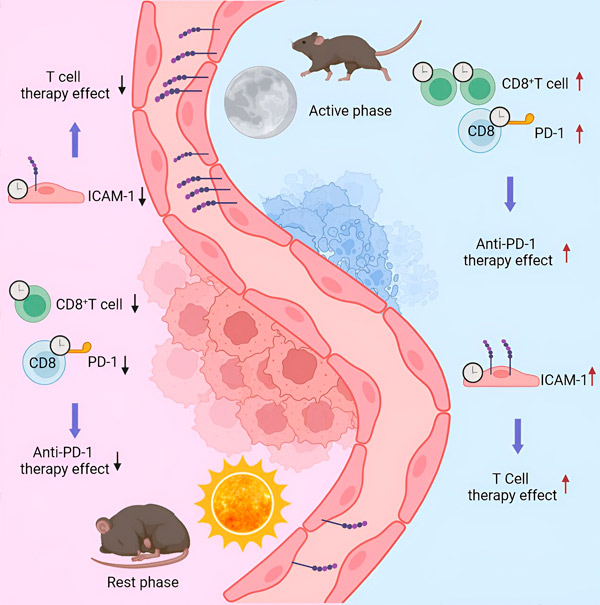
通过研究肿瘤免疫系统在一天中的变化,日内瓦大学和慕尼黑大学的科学家展示了它们对患者诊断和治疗的影响。
目前最有前景的抗肿瘤治疗方法是免疫疗法,旨在增强患者的免疫系统,从而对抗癌症。然而,尽管这些方法在某些情况下疗效显著,但有时效果却令人失望。这种差异性该如何解释?
在之前的研究中,日内瓦大学 (UNIGE) 和慕尼黑大学 (LMU) 的研究小组发现,免疫系统的节律性对肿瘤的生长至关重要。如今,这些科学家又证明,肿瘤的免疫特征会根据活检时间的不同而发生显著变化。
这些暂时的变化可能导致误诊和不恰当的治疗。此外,一些此前被忽视的治疗靶点可能成为对抗这种疾病的关键。这项发表在《细胞》杂志上的研究结果可能对临床治疗和药物研发产生重大影响。
2022年,由日内瓦大学医学院和慕尼黑大学病理学与免疫学系及炎症研究中心教授Christoph Scheiermann领导的研究团队观察到了一个意想不到的现象:肿瘤的生长和严重程度与免疫细胞的昼夜节律相关。“但要将这些结果应用于临床,我们需要在一个接近现实的模型中了解其细节,”Scheiermann说道。
为此,科学家们给一组小鼠注射了黑色素瘤细胞,并在两周后于一天中的不同时间收集了产生的肿瘤。根据一天中的时间以及动物的免疫激活情况,免疫细胞的数量、类型和特征发生了显著变化。这可能对临床研究具有重要意义。

来源:Cell (2024). DOI: 10.1016/j.cell.2024.04.015
“在医院,患者会接受活检以识别肿瘤及其免疫特征,”Scheierman 解释说。“然后根据评估结果确定治疗方案,尤其是免疫疗法。现在,根据活检的时间,浸润的免疫细胞数量可能非常高(肿瘤被归类为‘热’肿瘤)或非常低(‘冷’肿瘤),即使是同一个肿瘤。在错误的时间进行活检可能会导致错误的诊断。”
免疫疗法的时机
为了尽可能接近临床现实,科学家们对小鼠组应用了两种已获批准且广泛使用的治疗方法:CAR-T 细胞(专门设计用于识别和靶向肿瘤特异性蛋白质)和免疫检查点抑制剂,后者可抑制免疫系统的自然刹车以增强其对抗肿瘤的活性。
“如果在错误的时间给药,这些治疗方法就没有效果。如果在正确的时间给药,肿瘤负担可以显著降低,”Scheierman 解释说。“肿瘤中存在或不存在免疫细胞是一个因素,但它们的特性和行为也是一个因素。”
事实上,根据用于这些治疗的分子元素的调制方式,应用时机至关重要。在正确的时间,需要摧毁的细胞会被立即识别。在错误的时间,目标分子表达水平较低,药物无法发挥作用。
调整治疗时间表和治疗方法
这些小鼠研究得到了免疫疗法后患者生存率分析的支持。清晨治疗——在人体免疫激活高峰期——与更高的生存率有系统性相关性。研究计划评估改变筛查和治疗时间对患者的影响。其他项目将探索迄今为止未被充分重视的潜在药物靶点。
此外,这些关于免疫节律的发现具有更广泛的意义:一方面,在个性化医疗方面,要根据患者的时间特征调整治疗方法(10-20%的人的生物节律与一般人群不一致),另一方面,在其他病理,特别是自身免疫性疾病的背景下。

